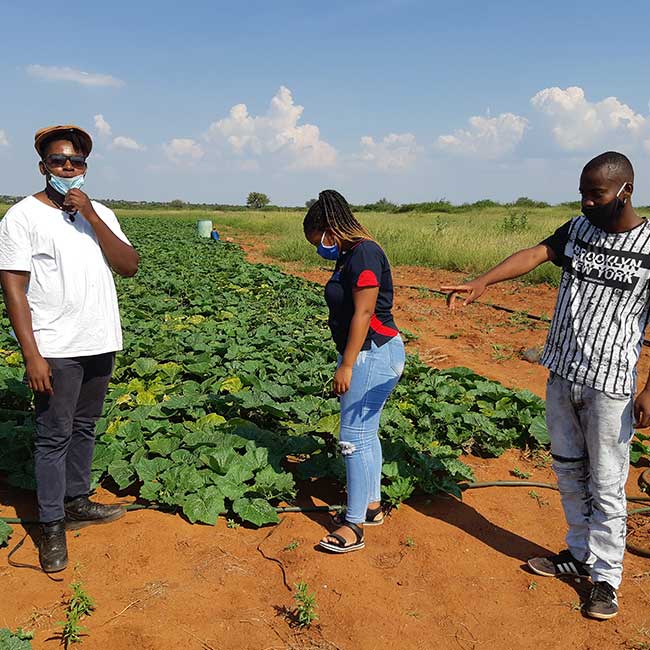Research
Questions
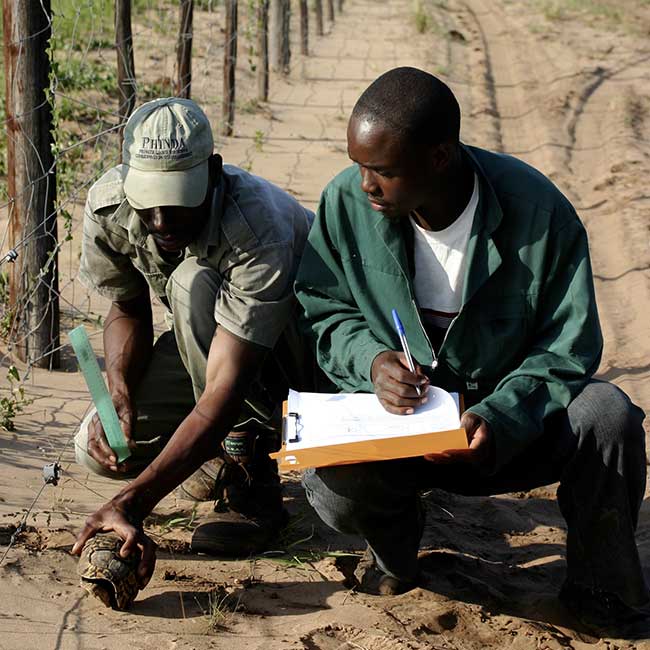
Priority conservation research questions for prospective students
Are you a student looking for some conservation-relevant ideas for a research project? Are you interested in contributing to pressing conservation challenges in southern Africa? The EWT has identified a list of priority research projects that we believe will make a difference in effectively conserving our biodiversity and ecosystems.
Prospective students are welcome to contact relevant programme managers for clarification on the projects, BUT PLEASE NOTE THAT THESE PROJECTS ARE NOT CURRENTLY FUNDED and represent an up-to-date “wish list” of the EWT’s current conservation research priorities.
african crane conservation programme
Keywords/themes: breeding biology, anthropogenic threats, climate change
Blue Cranes in the Western Cape
- How does Blue Crane breeding success vary across the Overberg, and what are the potential drivers of this?
- How sensitive are breeding Blue Cranes to changes in temperature, and how will this affect the resilience of the Western Cape populations in the face of climate change?
- How much crop damage are Blue Cranes (and other large birds) responsible for in the Swartland and Karoo agricultural regions? Are crop protection methods, such as using a non-lethal crop treatment (e.g. Anthroquinone), effective in deterring cranes?
- What are the characteristics of roosting sites used by cranes across their range, and how sensitive are these to threats? How do activity patterns of cranes change around nests, and how far do adults forage from nests? This information can help guide appropriate conservation action necessary to protect roost sites and limit human disturbance.
Wattled and Grey Crowned Cranes
- How much suitable breeding habitat is available for Wattled Cranes in South Africa, and how vulnerable are these habitats to anthropogenic impacts?
- What do we know about the movement ecology, breeding biology and success, and the extent and impact of threats such as power line collisions, illegal trade, and habitat loss on South Africa’s Grey Crowned Crane population?
- What are the impacts of human disturbance on Grey Crowned Crane breeding productivity in east Africa?
For more information email our programme manager Damian Walters
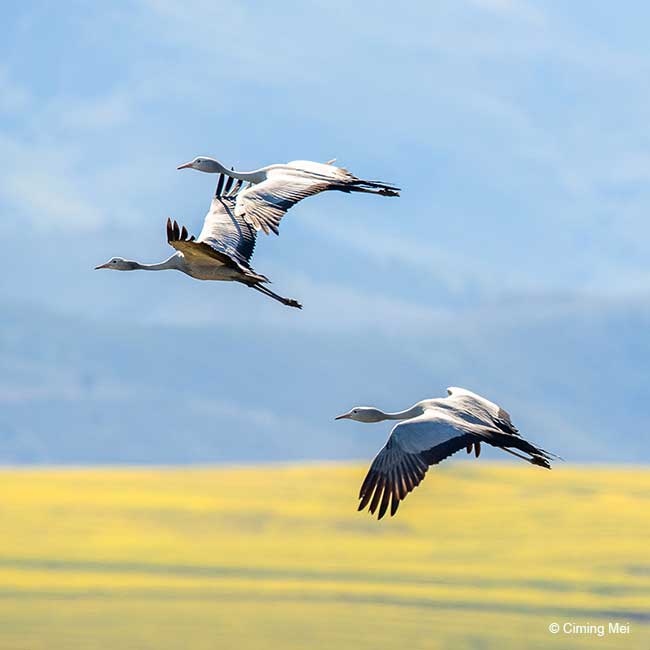

Birds of prey programme
Keywords/themes: movement ecology, poisoning, breeding biology
Vultures
- Are the Vulture Safe Zones improving the breeding success and population trends of South Africa’s threatened vultures?
- Using previous results of habitat suitability models, can we identify suitable and safe sites to support an active Bearded Vulture (Gypaetus barbatus) captive rearing and recovery programme?
- Since 2006, the EWT has been coordinating the vulture tagging and resighting database in southern Africa. Using this long-term database, we would like to address the following questions:
- Are there any negative effects of using patagial wing tags (with respect to breeding success and productivity), and should we use new, less invasive colour tags?
- Can wing tags effectively determine survival and dispersal in individuals through resighting records?
- What is the average longevity of wing tags on vultures? Does this vary between species?
- Are landowners and/or members of the public more likely to report the presence of vulture carcasses to the EWT if they are wing tagged and/or ringed? What does this mean for population monitoring?
- What is the nest site occupancy and breeding success of Critically Endangered White-backed Vultures in the Kalahari?
- What are the baseline levels of lead ingestion and poisoning in Lowveld vultures?
- Vultures have the potential to act as long-distance vectors of infectious diseases. What are the ecto- and endoparasite loads, the prevalence of HPAI and Newcastle’s Disease, basic health parameters, genetics, and microbiome of vultures?
Martial Eagles in the Karoo
- We aim to assess the population dynamics, breeding, spatial ecology and diet of Martial Eagles that breed on Eskom transmission lines in the central Karoo, South Africa. The mechanisms driving changes in population sizes, particularly outside protected areas, are poorly understood. Further research to elucidate the drivers of the Martial Eagle’s decline is imperative for conserving the species. We need to better understand the factors that influence Martial Eagle breeding, foraging and ultimately, population dynamics, both within and outside of protected areas of South Africa.
African raptors
- What are the migratory routes and non-breeding range of Wahlberg’s Eagle (Hieraaetus wahlbergi)? What are the threats that could impact the species along its migratory flyway?
- What is the status of the over-wintering populations, movements and foraging habits of Lesser Kestrel (Falco naumanni) and Amur Falcon (Falco amurensis) populations in South Africa?
- What are the seasonal changes in Pel’s Fishing-owl territory occupation, foraging, and habitat use? These data will inform conservation interventions and protect known breeding and foraging sites.
- What are the levels of heavy metals in the eggshells of raptors in the Lowveld? This will help us use raptors as indicators of environmental health and provide a baseline level for the levels of different contaminants in the eggshells of birds of prey in Limpopo and Mpumalanga.
For more information email our programme manager Dr Gareth Tate
CARNIVORE CONSERVATION PROGRAMME
Keywords/themes: reintroduction planning, reintroduction success, human-wildlife conflict
Understanding the ecology and conservation status of Wild Dogs
- What is the historic distribution of Wild Dogs in Africa?
- What are the different population scenarios of wild dogs in the metapopulation when specifically focused on assessing regulatory mechanisms across a range of biotic and abiotic factors?
- What are the genetic relationships between Wild Dog populations in South Africa? This can be done through the construction of a national Wild Dog studbook that can be used to guide effective population management.
- What is the genetic diversity of Wild Dogs in Africa, and are there legitimate subspecies? This is vital as it will impact the selection of individual animals and sites for reintroductions.
- Using data from the Carnivore Conservation Programme, determine the population and current demographics (pride sizes, ages of dominant males, litter sizes, cub survival, etc.) of lions in the Greater Limpopo Transfrontier Conservation Area and assess whether these are representative of a healthy population? In addition, determine how factors such as prey movement and availability contribute toward seasonal lion density.
- Investigate what machine learning and citizen science methodologies are most effective for assessing the population and population trends of large carnivores.
- To improve our predator management plans, use data collected in metapopulation reserves (in South Africa) and in the predator guild reconstruction in Zinave National Park (Mozambique) to determine how reintroductions of large carnivores impact population dynamics of other large carnivores, smaller carnivores, and prey.
Understanding conservation needs of wild dogs in the context of metapopulations and boundaries of Protected Areas
(issues surrounding where to reintroduce, how to make sure they establish, mitigate reintroduction and metapopulation-related problems)
- How do we refine the carrying capacity equations for large carnivores as developed by Hayward (Hayward, M.W., O‘Brien, J., & Kerley, G.I.H. 2007a. Carrying capacity of large African Predators: Predictions and Tests. Biological Conservation 139: 219-229)? These models have high variability and are outdated, and current analysis techniques should allow for a more accurate set of equations.
- To identify suitable reserves for re-establishment of Wild Dog populations, and to support evidence-based Wild Dog management strategies, determine how Wild Dog demographics, population growth rates, and extinction rates differ under varying management regimes and intensities.
- What is the relative importance of pull factors (game farms with high densities of prey) and push factors (Lion density) in driving Wild Dog dispersal from protected areas?
- Does the density of apex predators impact the likelihood of Wild Dogs dispersing from protected areas? Is there a threshold of densities (e.g., of Lions) above which Wild Dogs disperse? How do pack, pride, and clan size impact the ability of Wild Dogs to safely coexist with apex predators? For example, perhaps large prides are easier to avoid than many small prides at the same density. This has implications for Lion and hyaena management when reserves want to keep Wild Dogs and Cheetahs.
- Our reintroduction feasibility assessments are currently based on educated guesses. By analysing data from past reintroductions, create an evidence-based assessment framework to illustrate what factors impact the successful reintroduction of Cheetahs and Wild Dogs.
Understanding and mitigating threats
(poisoning, snaring, retaliatory killing, road strikes, prey depletion, etc.)
- Does snaring have a quantifiable effect on Wild Dogs in Kruger National Park, and do snare removal projects reduce the effects of snaring on Wild Dogs?
- What are the most effective methods for reducing the levels of Human-Wildlife Conflict, and in what context and combination should they be used? In other words, how do we keep predators from killing livestock and high–value game? Many methods have been proposed and tried but without rigorous testing. For example, we need to understand the effectiveness of bio–boundaries, including the type of scent, longevity, and species it deters. We need long-term data collection on sympatric herds of livestock and adjacent game farms where a mitigation measure is applied to one farm or herd and not to the other. In this way, we will be able to validate methods and provide robust evidence-based recommendations to farmers, protected area managers, and government authorities.
- What are the most effective methods for reducing the perceived severity of Human-Wildlife Conflict? In other words, how do we make farmers more tolerant when carnivores kill livestock and high–value game? This involves testing things like insurance schemes, ecotourism, community education, and financial incentives aimed at encouraging ethical farming. In combination with reducing actual losses to predators, this will help us to provide farmers with practical, evidence-based, holistic recommendations for farming in a predator-friendly manner.
- What is the role of Human-Wildlife Conflict in Lion poaching for their parts? We do not expect that HWC is a driver of the Lion trade in and of itself. We suspect that when Lions are killed in retaliation for livestock losses, parts are then taken to sell. Career poaching and retaliatory killing require different investigative approaches and solutions. Understanding this relationship will help us to develop more effective approaches to address Lion poaching from a community level.
- Does the reintroduction of Leopards to the Karoo reduce HWC with caracals and jackals? This long-standing conflict seems to be caused by severe overpopulations in mesocarnivores due to the absence of apex predators.
- What is the impact of Livestock Guardian Dogs on apex predators and mesocarnivores? We must understand how Leopards respond to herds with LGDs versus those without LGDs. We also need to understand how LGDs impact other species like jackals and Caracals. This will give us evidence to determine how effective LGDs are in creating safe spaces for carnivores.
- Which livestock guardian animals (donkeys, dogs, alpacas, etc.) are most effective for creating safe space for carnivores? Are different species or breeds of guardian animals more effective with different livestock species? Is there an optimal herd to guardian animal ratio?
For more information email our programme manager Derek van der Merwe
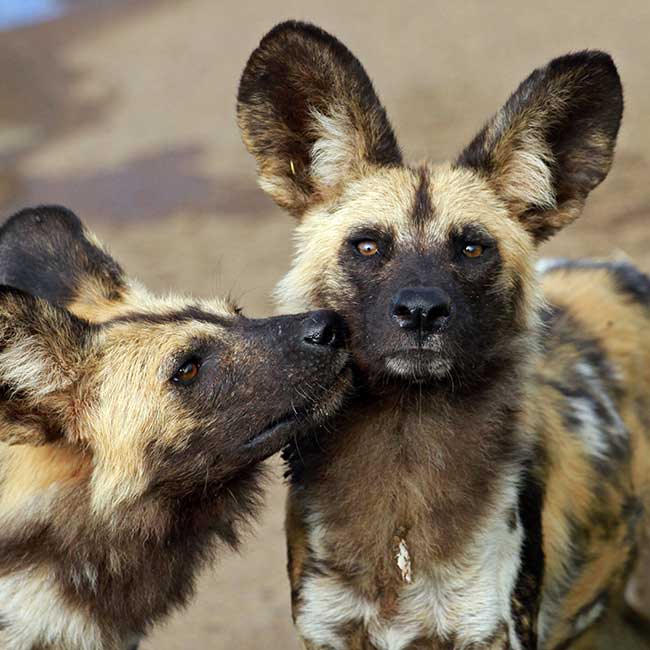
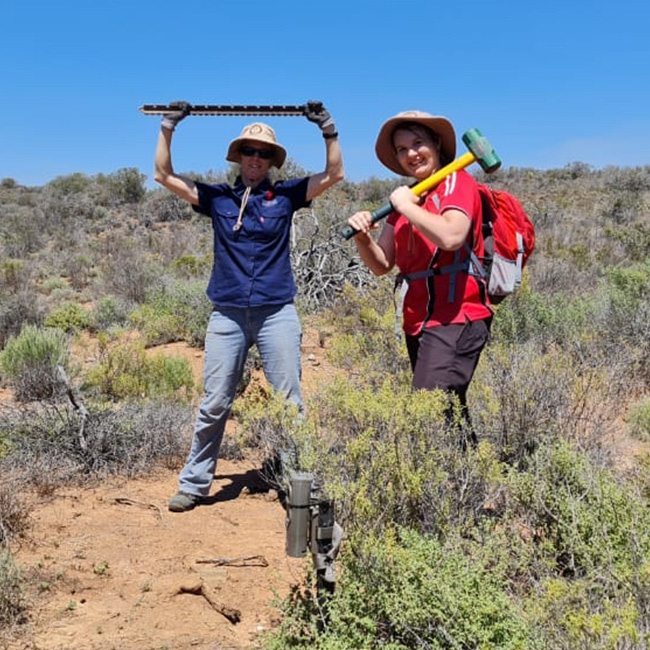
DRYLANDS CONSERVATION PROGRAMME
Keywords/themes: restoration, predation risk, movement ecology, climate change, human-wildlife conflict, socio-economic development
Riverine Rabbits
- What is the impact of jackal, leopard and caracal predation on Riverine Rabbit (Bunolagus monticularis) populations in the Nama and Succulent Karoo?
- What is the impact of predation by raptors on Riverine Rabbit (Bunolagus monticularis) populations in the Nama and Succulent Karoo?
- What are the habitat requirements and movement patterns of Riverine Rabbits in the Succulent Karoo?
- Can a machine learning protocol be developed to distinguish individuals of species without unique markings, such as Aardvark and Riverine Rabbits, captured on camera traps?
Karoo tortoises
- Which strategies most effectively mitigate crow predation on tortoises in the Nama and Succulent Karoo?
Dryland restoration
- What are the most effective methods of habitat restoration in the Karoo?
- What are the survival rates of nursery–grown plants on restoration sites in the Nama Karoo, with and without protection?
- How do survival rates of two nursery-grown riparian plant species compare when planted in association with micro–catchments vs plough lines at two restoration sites in the Nama Karoo?
Dryland agriculture
- What methods could mitigate human-wildlife conflict and promote more ethical farming practices in the Karoo?
- Are Nama Karoo landowners aware of the impacts of climate change, and what are their adaptation and mitigation techniques to climate change?
- How do stakeholders respond to the Responsible Wool Standards Initiative, and do the standards result in a tangible benefit to biodiversity on Karoo rangelands? (A comparison between farmers complying with the standards and those that do not).
socio-economic development
- What is the long-term environmental impact of mining, agriculture and other development along South Africa’s West Coast?
- What are the gaps, weaknesses and strengths of existing water management policies and legislation, and how can they be improved for cooperative water governance around freshwater ecosystems in the Cape?
- What is the long-term environmental impact of mining, agriculture and other development in the Northern Cape?
- Using the Nieuwoudtville project as a case study, what are the socio-economic and environmental impacts of nature-based tourism?
For more information email our programme manager Johan du Plessis
THREATENED AMPHIBIAN PROGRAMME
Keywords/Themes: freshwater ecology, flagship species, acoustic monitoring, citizen science, wetland ecology
Species
- What is the current distribution of the elusive Amathole Toad (Vandijkophrynus amatolicus) in the Eastern Cape highlands?
- Can we use photographic recognition software to conduct a population census of the Endangered Western Leopard Toad (Sclerophrys pantherina) in the Western Cape?
- Can we use citizen science to conduct egg-clump counts and determine the phenology and population dynamics of the Endangered Kloof Frog (Natalobatrachus bonebergi)?
Is acoustic monitoring a viable technique to determine population estimates and densities of the Endangered Pickersgill’s Reed Frog (Hyperolius pickersgilli)?
Habitats
- Can we develop a tool to use frogs as indicators of freshwater health?
- What is the resilience of wetland ecosystems in KwaZulu Natal in the face of climate change?
- Can comparative studies of social and ecological assessments be used to determine the effectiveness of restoration for socio-ecological resilience?
For more information email our programme manager Dr Jeanne Tarrant
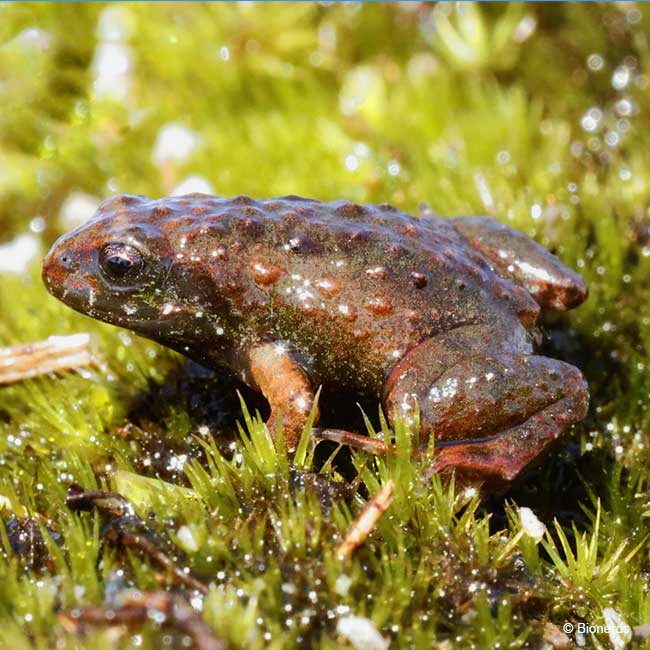
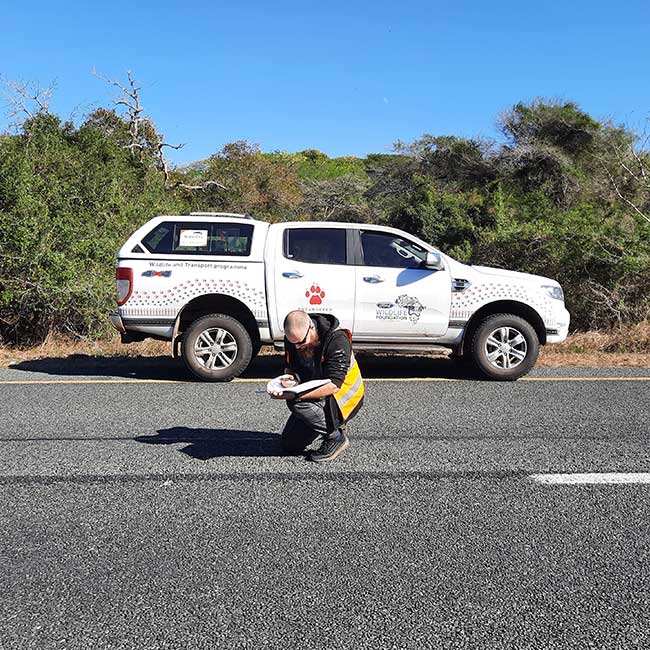
WILDLIFE AND TRANSPORT PROGRAMME
Keywords/themes: roadkill, mitigation
Expand the scope and focus of roadkill studies in South Africa
- Expand the scope and focus of roadkill studies in South Africa
- How applicable is the EWT’s roadkill monitoring protocol in various habitats and circumstances? How might the protocol be modified to improve its reliability?
- What rates of roadkill are observed in various habitats?
- Assess the use of existing mitigation options for roadkill
- Which existing structures facilitate wildlife crossings? What species use them? How might structures be altered to increase their use? What are the costs associated with these alterations?
- What are the indirect impacts of fences designed to prevent the movement of animals across road infrastructure?
- Can different odours be used as a repellent for livestock species grazing on roadside verges and prevent them from wandering onto the road and causing road accidents?
- Determine whether deliberate collision is a threat
- Is there a correlation between the locality of the research (urban, rural, agricultural etc.) and the type of animal deliberately hit (e.g., jackals are considered pests by some farmers)?
- Assess the use of roadkill for muthi
- What percentage/number of animals used by sangomas for muthi purposes are sourced from roadkill?
- What freshness of carcass is required by the sangomas?
- Does sourcing wildlife from roadkill victims reduce the need for alternative harvesting mechanisms?
- Monitoring the impacts of roads on Serval on the N3 highway, South Africa.
- Serval have been documented as impacting roads on the N3 highway, with over 80 killed over two years. What impact does this have on the population?
- What are Servals’ behaviour around roads in general? Is it determined by prey base?
- Monitoring the impacts of roads on Bat-eared Fox on the R360, South Africa.
- Bat-eared Foxes have been documented as being impacted on the R360 road. What impact does this have on the population?
- What is Bat-eared Fox behaviour around roads in general? Is it determined by prey base?
- What species are attracted to or repelled by roads and/or rail? Use of spoor surveys adjacent to and buffering (e.g. 100m and 1 km away) these two linear infrastructures can indicate species behaviour around them to generate an understanding of specific species that avoid or are attracted to linear infrastructure and the potential barrier effects.
- Does driver behaviour change in response to roadkill signage on rural roads?
For more information email our programme manager Wendy Collison
WILDLIFE AND ENERGY PROGRAMME
Keywords/Themes: electrocution risk, bird mortalities
- Can key morphometrics of birds of prey be used as an identification technique for carcasses?
- Can power pole density be a surrogate for avian electrocution risk in southern Africa?
- Can remote sensing tools help identify electrocution risk for birds based on the identification and mapping of distribution power poles using satellite imagery?
- The development of a practicable remote bird collision monitoring system – real-time HD video stream covering several power structures and collision vibration detection.
- What is the physiological effect on birds from the electromagnetic fields produced by electrical infrastructure?
- What is the status of power line ecology research in Africa: Quo Vadis? (a review of power line ecology research in Africa)
For more information email our programme manager Oscar Mohale

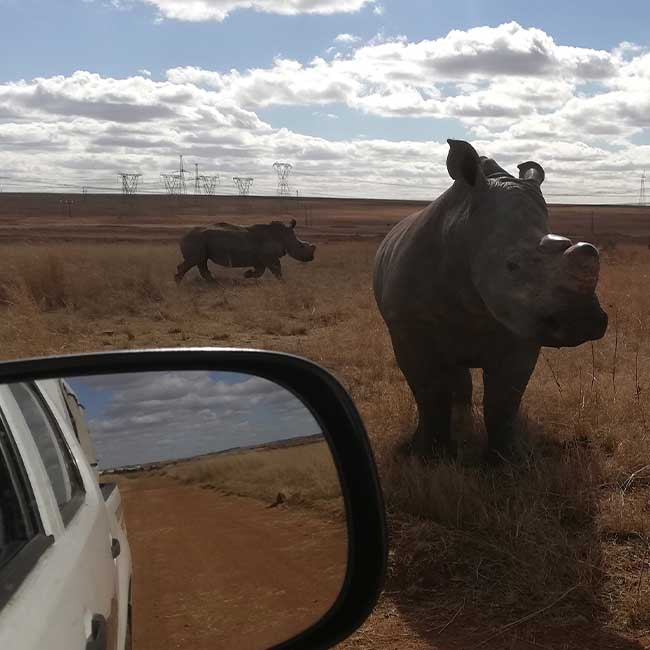
WILDLIFE IN TRADE PROGRAMME
Keywords/themes: illegal wildlife trade, pangolins, poaching, rhinos, wildlife consumption, smuggling, responsible tourism, alternative livelihoods
Illegal trade in wildlife
- How has Covid-19 lockdown and global travel restrictions affected wildlife crime? Are poachers becoming more creative, using new means to transport products when international travel is limited?
- Have the bans on wildlife consumption, first in China and increasingly in other countries, affected the scale of illegal wildlife trade sourced in Africa, specifically from South Africa?
- To what extent has the legal trade in lion bones contributed to the poaching and smuggling of wild lions? What is the conservation impact of the captive lion industry? What are the uses for lion parts in Africa and Asia?
- How many Temminck’s Ground Pangolins (Smutsia temminckii) are being removed from the wild every year in South Africa? Who is responsible, why, and how do we reduce the impacts? How do these removals affect the wild population?
- Which bird species are being removed from the wild in South Africa for illegal trade, and in what quantities are they being extracted? What are the impacts on wild populations? Is the illegal trade being conducted at subsistence or organised level?
- Which reptile species are being removed from the wild in South Africa for illegal trade, and in what quantities are they being extracted? What are the impacts on wild populations? Is the illegal trade being conducted at subsistence or organised level?
- What other animal taxa, for example, insects, are being exploited for the illegal wildlife trade, and what is the conservation impact?
- What is the scale of the illegal trade in medicinal plants?
- What are the transport routes of illegally traded cycads, and what is the volume of cycads smuggled out of the country versus retailed domestically?
- How often do timber cargo ships call into South African ports en route to Asia, and can the waybill information for each of these ships be analysed to determine timber species composition, volumes, sources, etc.?
- When looking at community engagement in wildlife trade, both in promoting sustainable, legal trade, and discouraging unsustainable, illegal trade, what lessons can be learnt? Can we apply these lessons to address wildlife crime at the source and, through doing so, explore possibilities for alternative livelihood options for people who may have once relied on illegal wildlife trade?
- How would the market for rhino horn respond if international trade were legalised? Will demand change? Will poaching increase or decrease? Will the black market for rhino horn still exist?
- What are the drivers of demand for the rarest and endangered animals or plants?
- Regarding smuggling methods and routes:
- Which are the most likely routes (ports of entry and exit) for animal and plant products in Africa for the muthi trade?
- What methods are used at ports of entry and exit to detect illegal wildlife and wildlife products?
- How effective are the current detection methods, and how can they be improved?
- How are wildlife and wildlife products smuggled into and out of South Africa?
- Which ports of entry and exit are currently the most vulnerable to the illegal international trade in wildlife and wildlife products?
- What are the supply chains and trade routes of illegally traded wildlife products?
- Corruption is a major problem in the illegal wildlife trade because it impedes the effective implementation of the law. What can be done to reduce or prevent corruption among law enforcement officials dealing with wildlife products, and what is currently being done?
Responsible tourism
- How do wildlife-based tourism facilities advertise their activities to international and domestic tourists?
- What role does the tourism hospitality sector play in influencing where their guests go to enjoy our wildlife?
- What role can international tourists play in improving the responsibility of the wildlife-based tourism sector towards biodiversity and conservation of our environment?
- What role can domestic tourists play in improving the responsibility of the wildlife-based tourism sector towards biodiversity and conservation of our environment?
- How can we encourage both domestic and international tourists to become more responsible in their choices of wildlife-based tourism activities?
Wildlife economy
- What are the conservation benefits/impacts of different wildlife-based land use enterprise types (e.g. hunting, breeding, tourism, meat production) within the private wildlife sector, and how do these compare to other (non-wildlife) land use activities (such as livestock production, crop production etc.)?
- What are the socio-economic benefits of trophy hunting, and how do these compare to other (non-wildlife) land use activities?
For more information email our programme manager DR Andrew taylor
PEOPLE IN CONSERVATION PROGRAMME
Keywords/Themes: biodiversity stewardship, ecotourism, responsible tourism, livelihoods, communities
Responsible tourism
- Ecotourism and responsible tourism have long been regarded as a means of reducing poverty and generating livelihoods for the rural poor. What are the experiences and lessons learned through developing tourism enterprises as a poverty alleviation mechanism in different regions and settings in South Africa?
- What are the impacts of ecotourism or responsible tourism ventures on the communities they are situated in? Do experiences differ across types of tourist offerings? How do these compare with experiences elsewhere in Africa?
Biodiversity stewardship
- Biodiversity stewardship is a mechanism that aims to improve the conservation of priority biodiversity areas through the development of agreements between conservation authorities and private and communal landowners. Do landowners benefit from these agreements? Are these benefits sufficient to motivate landowners to re-commit to biodiversity stewardship once the agreement expires?
- What factors contribute to the long-term implementation of effective biodiversity stewardship agreements?
- What were the processes and experiences of parties leading to the development of Biodiversity stewardship agreements by different groups of communal landowners? What were the key lessons learned during the development of the agreements? Did anticipated benefits materialise in the post-declaration period? What were the key lessons, benefits and challenges?
For more information email our programme manager Dr Jenny Botha
